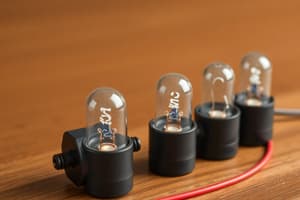Podcast
Questions and Answers
De eenheid van spanning wordt gemeten in?
De eenheid van spanning wordt gemeten in?
Volt (B)
De eenheid van stroom wordt gemeten in?
De eenheid van stroom wordt gemeten in?
Ampere (B)
De eenheid van vermogen wordt gemeten in?
De eenheid van vermogen wordt gemeten in?
Watt (A)
Flashcards are hidden until you start studying
Study Notes
Electricity: Exploring Ohm's Law and Staying Safe
Electricity powers our homes, computers, and cities, but it's not just about flipping a switch. Ohm's Law and electrical safety are essential components of understanding and harnessing the power at our fingertips.
Ohm's Law
[Image 1] Ohm's Law diagram
Ohm's Law is a fundamental principle in electricity, named after German physicist Georg Ohm. It states that the current (I) flowing through a conductor between two points is directly proportional to the voltage (V) across the two points, and inversely proportional to the resistance (R) of the conductor. This relationship can be expressed mathematically as:
[I = \frac{V}{R}]
This equation allows us to calculate any one variable if we know the other two. For example, if you want to find the current through a resistor with a known voltage and resistance, you can plug these values into the formula:
[I = \frac{12 \text{ volts}}{1000 \Omega} = 0.012 \text{ amps}]
Electrical Safety
Electricity can be dangerous if not respected and understood. Here are some key safety tips:
- Understand electrical hazards: The main hazards are electrical shock, fires, and explosions.
- Inspect cords and wiring: Replace damaged cords and wires immediately and avoid using frayed cords.
- Use appropriate plugs: Use the correct plug for the correct outlet; never force a plug to fit into an outlet.
- Keep water away from electrical components: Water conducts electricity and can lead to shocks or fire hazards.
- Protect yourself: Wear dry, non-conductive clothing and use insulated tools when working with electricity.
- Follow label instructions: Follow the manufacturer's instructions for electrical devices and appliances.
- Mind your surroundings: Keep your work area clean and free of tripping hazards.
- Use proper grounding: Always use three-prong outlets and grounded extension cords.
- Unplug devices before repairs: Turn off and unplug all devices before attempting repairs or replacements.
- Learn CPR: Knowing cardiopulmonary resuscitation (CPR) can save a life.
Remember, electricity is a powerful force that can be harnessed safely with proper education and respect. By understanding Ohm's Law and following safety protocols, you can responsibly use electricity and avoid hazards.
[Image 1]: An illustration of Ohm's Law where the voltage (V) is applied across a resistor (R), resulting in current (I) flowing through the circuit.
Studying That Suits You
Use AI to generate personalized quizzes and flashcards to suit your learning preferences.




